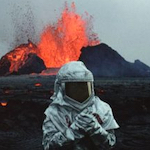 FIRE OF LOVE is a 2022 best documentary feature Oscar nominee that’s produced by National Geographic, but it’s not the sort of thing I associate with them. It’s one of a couple different movies telling the odd story of maybe history’s first married volcanologist couple, Katia and Maurice Krafft of France. They married in their twenties and spent the rest of their lives traveling around documenting volcano events. And I really mean right until the very end… we’re tipped off at the beginning that they died in the eruption of Mount Unzen in 1991.
FIRE OF LOVE is a 2022 best documentary feature Oscar nominee that’s produced by National Geographic, but it’s not the sort of thing I associate with them. It’s one of a couple different movies telling the odd story of maybe history’s first married volcanologist couple, Katia and Maurice Krafft of France. They married in their twenties and spent the rest of their lives traveling around documenting volcano events. And I really mean right until the very end… we’re tipped off at the beginning that they died in the eruption of Mount Unzen in 1991.
Though officially directed by Sara Dosa (TRICKY DICK & THE MAN IN BLACK), the credits are clear that it’s compiled from footage “from the deep archives” of the Kraffts. Clips of TV appearances, illustrative stock footage and a few bits of animation fill in some storytelling gaps, but it’s mostly footage shot by the Kraffts “and friends” – there’s no contemporary talking heads explaining what we should know about them or any of that type of bullshit. The volcanoes they’ll be seen visiting are credited as co-stars. The movie transports us to a different time and primarily lingers in what seems like a different world, far from any sign of human life, where we can see the earth’s raw power up close, as these self-proclaimed weirdos stare right into its gaping jaws, almost seeming tempted to jump in.
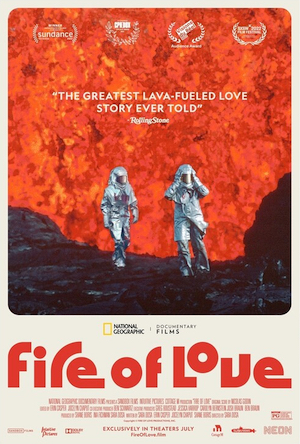 The breathy, almost whispered narration by performance artist/filmmaker Miranda July (ME AND YOU AND EVERYONE WE KNOW) will probly seem pretentious to some, so if that’s you let me point out that it sounds almost identical to the kid’s narration in SHOGUN ASSASSIN. In fact somebody should try swapping soundtracks between the two movies. I’m pretty sure they would line up. July talks poetically about the Kraffts’ lightly documented love story and their much more closely chronicled obsession with seeing eruptions up close.
The breathy, almost whispered narration by performance artist/filmmaker Miranda July (ME AND YOU AND EVERYONE WE KNOW) will probly seem pretentious to some, so if that’s you let me point out that it sounds almost identical to the kid’s narration in SHOGUN ASSASSIN. In fact somebody should try swapping soundtracks between the two movies. I’m pretty sure they would line up. July talks poetically about the Kraffts’ lightly documented love story and their much more closely chronicled obsession with seeing eruptions up close.
I’m not a scientifically minded person, so I kind of like that the movie is vague about what they’re actually learning from this research. It’s more interested in the unlikelihood of two people driven to do something so unusual finding each other and making it work, contrasted against the stunning beauty of this primally terrifying phenomenon of the plates under the earth shifting and causing powerful releases of hot gas, magma and ash. The images in their footage are straight up astonishing. Bursts of glowing orange material spraying, splashing, showering down. What looks like sparks are later revealed to be red hot projectile rocks, some of them very large. The Kraffts describe having to take turns on lookout duty while the other sleeps, ready to roll each other out of the way if a flying boulder is about to drop on them.

At times it’s hard to believe or process what we’re looking at. The enormous, flowing rivers of magma are otherworldly, hypnotic to watch. The footage can go on for a while without any talking or explaining, and I wouldn’t mind if it went longer. They claim it’s not that dangerous to be a few feet away from this stuff, and they don’t seem scared at all. Sometimes they wear crazy looking silver suits for protection, but usually they don’t. They’re used to having holes burn through the ass part of their pants from the heat.
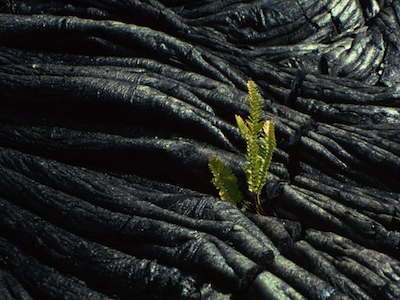 Sometimes they’re exploring the aftermath, no current danger. Strange formations of melted black rock give the landscape the appearance of a barbarian age or an alien planet. Katia likes to climb around, run her hands over surfaces, pick things up. It seems very peaceful.
Sometimes they’re exploring the aftermath, no current danger. Strange formations of melted black rock give the landscape the appearance of a barbarian age or an alien planet. Katia likes to climb around, run her hands over surfaces, pick things up. It seems very peaceful.
In one scene she’s examining shiny black objects, like strange knives. One she was examining for a bit before I realized it was (I believe) formerly a bird. In another part there’s this shot of a bunch of bones in the dirt and suddenly you put it together that the pit that holds them is a perfectly formed mold of the elephant they once belonged to, trunk and all. The poor thing got blasted with heat and almost completely dissolved in an instant, leaving behind only bones and negative space.
I don’t think we can say we can understand the Kraffts – whatever single-minded pursuits we have are difficult to relate to one that pretty much boils down to abandoning civilization to stare down the center of the earth until it devours you. But watching this footage we can see the allure, at least. They say they’re disappointed with the modern world, and this is quite a way to escape from it. Even at this distance, through curated footage, the sights are awe inspiring. Standing there, looking at it with your own eyes, feeling the heat of it, I can imagine how you might feel compelled to dedicate your life to it, like a priest after getting pissed on by Rawhead Rex.
The Kraffts say they don’t consider themselves filmmakers, they just have to make movies as a reason (and fundraiser) for their trips. There’s a scene where they return home and they seem uncomfortable in their cluttered offices, doing the chore of putting together a book or movie from their research, getting it over with so they can get back to doing more research.
One interviewer asks if what they do is “an alternative lifestyle.” And in a sense it is kind of like this kinky thing they do together. It seems neither of them want to live any other way and they happen to have each found the only living person who will indulge them. They say they literally couldn’t do it without each other, and that seems to be true – the opening scene is about them getting their vehicle stuck and unstuck in the snow. If it was only one of them they’d never make it to the volcano. (Unless the cameraman helped, I guess.) Anyway I don’t see how you could travel all the time and take all these risks with a husband or wife waiting for you at home not really getting the whole volcano thing. That would be terrible.
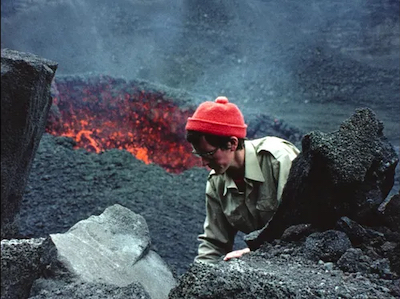 There’s a very specific vibe to the movie. The soundtrack compiles some tracks by Brian Eno, Air, and Nicolas Godin (a member of Air) and finds a particular type of primitive-sounding synth noodling that I guess fits what you would imagine if you were crate digging and found a mysterious old soundtrack for a French volcanology documentary. There’s also a part with Ennio Morricone’s “The Ecstasy of Gold,” since Maurice decided to stage a shot of a bunch of guys riding horses on a volcano.
There’s a very specific vibe to the movie. The soundtrack compiles some tracks by Brian Eno, Air, and Nicolas Godin (a member of Air) and finds a particular type of primitive-sounding synth noodling that I guess fits what you would imagine if you were crate digging and found a mysterious old soundtrack for a French volcanology documentary. There’s also a part with Ennio Morricone’s “The Ecstasy of Gold,” since Maurice decided to stage a shot of a bunch of guys riding horses on a volcano.
Visually it’s like THE LIFE AQUATIC WITH STEVE ZISSOU meets some kind of fantasy painting. Their ’70s clothes, Katia’s nerdy glasses, the 16mm educational film aesthetics, it’s all very cute, but not too cute in the face of what can only be described as the earth’s angry wrath. There’s a limit to how much we can chuckle at their spunkiness while teetering on the edge of the abyss. Maurice thinks it’s a funny idea to take a boat out on a lake of sulfuric acid. It melts the equipment he’s supposedly going to take measurements with, and then the winds get him stuck out there for three hours. Katia waits on the shore, July says she’s furious. We don’t get to know what the geologist he talked into going out there with him thinks. Later, on talk shows, he recounts the legend like a crazy story from his frat days. It comes across way more worrisome than amusing.
Side note: It’s weird to feel nostalgia watching a volcano documentary, but there’s a shot of Katia wearing an eruption of Mount St. Helens t-shirt the same as me and my siblings wore when we were little. My dad was a science guy, a chemical engineer working on submarines at the naval shipyard, and that day one of his co-workers showed up with his car covered in several inches of ash. They sealed samples of it in little plastic bags and gave them to us as souvenirs. He was so excited about this eruption and got us kids into it too. I could never explain it, but it seemed to make sense at the time.
 As a young rebel rocking the boat in the volcanology world, Maurice says it should be illegal to classify volcanoes. He blames that shit on bearded old intellectuals and prefers treating each volcano as an individual with a unique personality. Eventually they allow that there are two types: “red” (magma-spewing) and “grey” (exploding, ash-coughing). When they announce they’ve switched their allegiance from red to grey it feels like that dark moment in the music biopic when the drugs start being more of a burden than a party, inspiration is dwindling and the days seem numbered. The shift in tone is partly visual – no more bright orange, now everything is grey, covered in ash, and their boots are getting stuck in thick, gooey mud. For the first time we see the volcanoes encroaching on the real world – wrecking towns and villages, destroying homes, taking lives. It stops being an escape and becomes a disaster.
As a young rebel rocking the boat in the volcanology world, Maurice says it should be illegal to classify volcanoes. He blames that shit on bearded old intellectuals and prefers treating each volcano as an individual with a unique personality. Eventually they allow that there are two types: “red” (magma-spewing) and “grey” (exploding, ash-coughing). When they announce they’ve switched their allegiance from red to grey it feels like that dark moment in the music biopic when the drugs start being more of a burden than a party, inspiration is dwindling and the days seem numbered. The shift in tone is partly visual – no more bright orange, now everything is grey, covered in ash, and their boots are getting stuck in thick, gooey mud. For the first time we see the volcanoes encroaching on the real world – wrecking towns and villages, destroying homes, taking lives. It stops being an escape and becomes a disaster.
In 1985 Katia goes to Colombia on her own while Maurice is on a speaking tour, and is shaken by the aftermath of a mud slide that killed upwards of 20,000 people. She says it makes her embarrassed to call herself a volcanologist. Scientists predicted it, established evacuation plans, but according to the narration it was decided it was too costly. It’s an operatic illustration of problems we experience again and again, not just “acts of god” but also train disasters, contaminated water, failing electric grids, unending pandemics, and just health care in general. Yeah, we could do something, but we’d first have to establish a system that valued human life more than money. So forget it. Fend for yourself, sucker. If applicable. Which it isn’t when you get blasted by a volcano. RIP.
After that the Kraffts dedicate themselves to the project they call “Understanding Volcanic Hazards and Reducing Volcanic Risks.” Though they endanger themselves to get their close up documentation – comparing it to Russian Roulette – they want others to be safe. At Mount St. Helens Maurice finds a melted-together stack of multi-colored cassette tapes belonging to a friend and colleague whose body was never located. But we don’t even need that reminder. We know 1991 is getting closer.
As the movie tells it, by the time they lost that Russian Roulette game (buried in Unzen’s pyroclastic flow while standing side by side, facing the blast) their message had gotten across. Their footage and educational materials had convinced authorities to evacuate before predicted eruptions, saving countless lives.
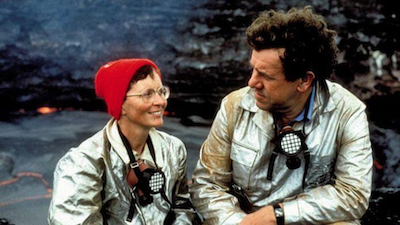 I can’t claim FIRE OF LOVE isn’t a sad movie, but it’s honestly more beautiful than anything. It’s the story of this perfectly matched pair who met at the right time, shared an overwhelming passion for this unusual activity, improbably managed to dedicate their lives to pursuing it together, died earlier than they probly wanted, but somewhat by choice, together, doing what they loved, and after making a mark on the world by inspiring those evacuations. Seems like a damn good life, actually.
I can’t claim FIRE OF LOVE isn’t a sad movie, but it’s honestly more beautiful than anything. It’s the story of this perfectly matched pair who met at the right time, shared an overwhelming passion for this unusual activity, improbably managed to dedicate their lives to pursuing it together, died earlier than they probly wanted, but somewhat by choice, together, doing what they loved, and after making a mark on the world by inspiring those evacuations. Seems like a damn good life, actually.
I remember being intrigued by a trailer for this at an indie theater, and I wish I would’ve gone because it must’ve been great on the big screen. It’s not on disc so far, but since Disney owns National Geographic you can watch it on Disney+.


























March 6th, 2023 at 11:07 am
Do they ever make documentaries of interesting people with dangerous professions and/or hobbies who are still alive or at least didn’t die a gruesome death?